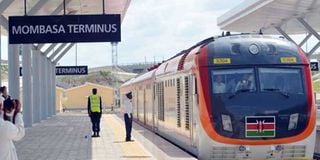SGR back in the news for wrong reasons; how did we end up here?

Madaraka Express arrives at the Mombasa Terminus in Miritini from Nairobi in July last year. FILE PHOTO | NATION MEDIA GROUP
What you need to know:
- SGR charges $33 (Sh3,300) per kilometre per tonne, whereas the cost by road is a quarter less.
- Such a huge difference makes it very difficult to convince customers to put their cargo on SGR
- The SGR was a government-to-government turnkey operation negotiated in a shroud of opaqueness and dumped upon the Kenyan population with the minimum of scrutiny.
The standard gauge railway (SGR) project is back in the limelight. As often the case, the fatally marred overly controversial undertaking has hit the headlines for the wrong reasons: Its dubious origins and very chequered operation.
The State Law Office wants a review and renegotiation of the operating agreement between the parastatal Kenya Railways Corporation (KRC) and Chinese operator Africa Star Railways.
The thrust of the Solicitor-General’s argument is, KRC is paying over the odds for several services and non-services making the SGR’s operating costs inordinately high.
SGR charges $33 (Sh3,300) per kilometre per tonne, whereas the cost by road is a quarter less. Such a huge difference makes it very difficult to convince customers to put their cargo on SGR.
SH500 BILLION
Taken to its logical extreme, it totally rubbishes the argument for both another rail cargo network and, in particular, the SGR. Even worse, there is the burning question of whether the government has, indeed, squandered in excess of Sh500 billion on such a project.
The initial intention was to have a seamless transport service from Mombasa to the Ugandan border and beyond, but which now ignominiously terminates at an outpost near Naivasha called Duka Moja.
The SGR was a government-to-government turnkey operation negotiated in a shroud of opaqueness and dumped upon the Kenyan population with the minimum of scrutiny.
It’s no exaggeration to say it has so far cost twice what it should have and the quotes submitted were around half of what it has cost so far. Why the government went for a more expensive non-tendered option is an open question, which most Kenyans can easily hazard a guess at the answer.
It has landed Kenya with a massive debt, which it’s having extreme difficulty paying and servicing, and its actual day-to-day operations run at a loss. Much of its construction is steeped in controversy, not least the fact that it cuts through our iconic Nairobi National Park instead of going around it.
The Solicitor-General is questioning costs and charges, which were premised on the wrong projections. Worse, Africa Star charges for things it does not actually do, like non-existent operations on the Phase 2A line.
DEFECTIVE DEAL
But how did Kenya end up with such a monumentally defective deal and project that costs a fortune and lacerates money right, left and centre.
The SGR gets a lot of publicity as it is as gargantuan as it’s high-profile. How many more projects, often in the name of development, litter our economic landscape and bleed us of money? How many less would there be had the proposals been subjected to the relevant financial, economic, social and environmental due diligence and scrutiny?
This brings me to one closer to my doorstep. A few years back, the Quinjan Group, operating as CNQC, hired space in a residential area on Ngong Road, ostensibly as a depot for its fleet of road construction trucks. It applied for a Nema camp-site licence, which was granted. But it has since transformed itself into a fully fledged industry producing bulk aggregate for road construction, complete with the associated noise and air pollution in a zoned residential area with domestic dwellings on one side and farmland on the other.
PLEAD IGNORANCE
This is done under the auspices and jurisdiction of the Kenya Urban Roads Authority (Kura), under the Ministry of Transport, Infrastructure, Housing and Urban Development. How it acquired the paperwork to do this is an open question and why Kura has not reined in the rogue operator an even bigger query. It certainly can’t plead ignorance.
This is now subject to a court case instigated by Nema. See the ironic and exceedingly embarrassing situation of a government authority, under the Department of Environment, Nema, in conflict with another, Kura, under the Transport one.
Much of what has been described above would not have taken place had both processes been conducted in a transparent and professional manner.
Over to you, CS Macharia.
Mr Shaw is an economic and public policy analyst. [email protected].





